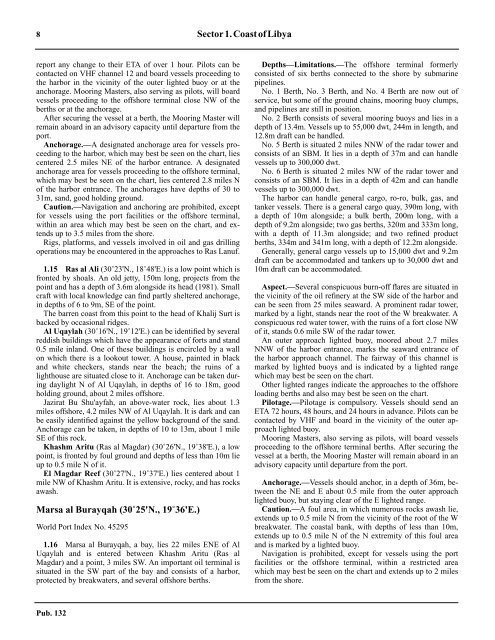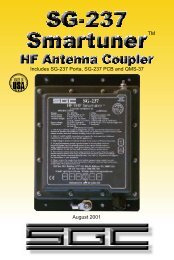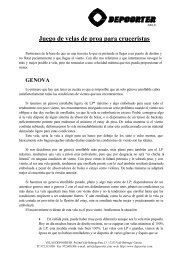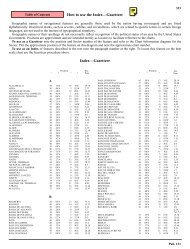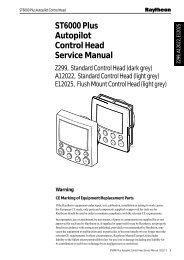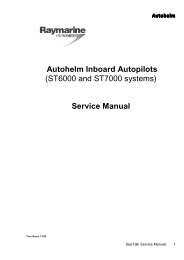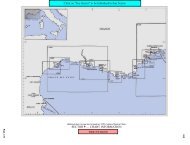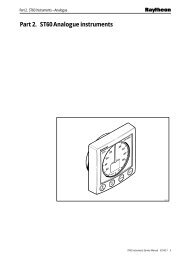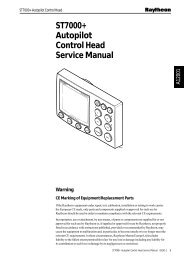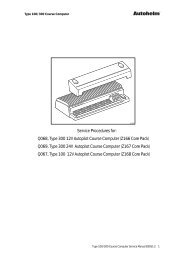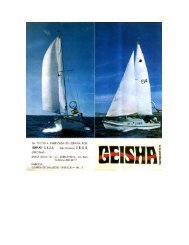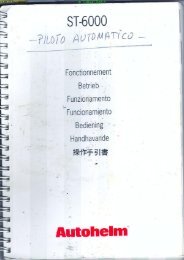8 Sector 1.CoastofLibyareport any change to their ETA of over 1 hour. Pilots can becontacted on VHF channel 12 and board vessels proceeding tothe harbor in the vicinity of the outer lighted buoy or at theanchorage. Mooring Masters, also serving as pilots, will boardvessels proceeding to the offshore terminal close NW of theberths or at the anchorage.1.14 After securing the vessel at a berth, the Mooring Master willremain aboard in an advisory capacity until departure from theport.1.14 Anchorage.—A designated anchorage area for vessels proceedingto the harbor, which may best be seen on the chart, liescentered 2.5 miles NE of the harbor entrance. A designatedanchorage area for vessels proceeding to the offshore terminal,which may best be seen on the chart, lies centered 2.8 miles Nof the harbor entrance. The anchorages have depths of 30 to31m, sand, good holding ground.1.14 Caution.—Navigation and anchoring are prohibited, exceptfor vessels using the port facilities or the offshore terminal,within an area which may best be seen on the chart, and extendsup to 3.5 miles from the shore.1.14 Rigs, platforms, and vessels involved in oil and gas drillingoperations may be encountered in the approaches to Ras Lanuf.1.15 Ras al Ali (30˚23'N., 18˚48'E.) is a low point which isfronted by shoals. An old jetty, 150m long, projects from thepoint and has a depth of 3.6m alongside its head (1981). Smallcraft with local knowledge can find partly sheltered anchorage,in depths of 6 to 9m, SE of the point.1.15 The barren coast from this point to the head of Khalij Surt isbacked by occasional ridges.1.15 Al Uqaylah (30˚16'N., 19˚12'E.) can be identified by severalreddish buildings which have the appearance of forts and stand0.5 mile inland. One of these buildings is encircled by a wallon which there is a lookout tower. A house, painted in blackand white checkers, stands near the beach; the ruins of alighthouse are situated close to it. Anchorage can be taken duringdaylight N of Al Uqaylah, in depths of 16 to 18m, goodholding ground, about 2 miles offshore.1.15 Jazirat Bu Shu'ayfah, an above-water rock, lies about 1.3miles offshore, 4.2 miles NW of Al Uqaylah. It is dark and canbe easily identified against the yellow background of the sand.Anchorage can be taken, in depths of 10 to 13m, about 1 mileSE of this rock.1.15 Khashm Aritu (Ras al Magdar) (30˚26'N., 19˚38'E.), a lowpoint, is fronted by foul ground and depths of less than 10m lieup to 0.5 mile N of it.1.15 El Magdar Reef (30˚27'N., 19˚37'E.) lies centered about 1mile NW of Khashm Aritu. It is extensive, rocky, and has rocksawash.Marsa al Burayqah (30˚25'N., 19˚36'E.)World Port Index No. 452951.16 Marsa al Burayqah, a bay, lies 22 miles ENE of AlUqaylah and is entered between Khashm Aritu (Ras alMagdar) and a point, 3 miles SW. An important oil terminal issituated in the SW part of the bay and consists of a harbor,protected by breakwaters, and several offshore berths.1.16 Depths—Limitations.—The offshore terminal formerlyconsisted of six berths connected to the shore by submarinepipelines.1.16 No. 1 Berth, No. 3 Berth, and No. 4 Berth are now out ofservice, but some of the ground chains, mooring buoy clumps,and pipelines are still in position.1.16 No. 2 Berth consists of several mooring buoys and lies in adepth of 13.4m. Vessels up to 55,000 dwt, 244m in length, and12.8m draft can be handled.1.16 No. 5 Berth is situated 2 miles NNW of the radar tower andconsists of an SBM. It lies in a depth of 37m and can handlevessels up to 300,000 dwt.1.16 No. 6 Berth is situated 2 miles NW of the radar tower andconsists of an SBM. It lies in a depth of 42m and can handlevessels up to 300,000 dwt.1.16 The harbor can handle general cargo, ro-ro, bulk, gas, andtanker vessels. There is a general cargo quay, 390m long, witha depth of 10m alongside; a bulk berth, 200m long, with adepth of 9.2m alongside; two gas berths, 320m and 333m long,with a depth of 11.3m alongside; and two refined productberths, 334m and 341m long, with a depth of 12.2m alongside.1.16 Generally, general cargo vessels up to 15,000 dwt and 9.2mdraft can be accommodated and tankers up to 30,000 dwt and10m draft can be accommodated.1.16 Aspect.—Several conspicuous burn-off flares are situated inthe vicinity of the oil refinery at the SW side of the harbor andcan be seen from 25 miles seaward. A prominent radar tower,marked by a light, stands near the root of the W breakwater. Aconspicuous red water tower, with the ruins of a fort close NWof it, stands 0.6 mile SW of the radar tower.1.16 An outer approach lighted buoy, moored about 2.7 milesNNW of the harbor entrance, marks the seaward entrance ofthe harbor approach channel. The fairway of this channel ismarked by lighted buoys and is indicated by a lighted rangewhich may best be seen on the chart.1.16 Other lighted ranges indicate the approaches to the offshoreloading berths and also may best be seen on the chart.1.16 Pilotage.—Pilotage is compulsory. Vessels should send anETA 72 hours, 48 hours, and 24 hours in advance. Pilots can becontacted by VHF and board in the vicinity of the outer approachlighted buoy.1.16 Mooring Masters, also serving as pilots, will board vesselsproceeding to the offshore terminal berths. After securing thevessel at a berth, the Mooring Master will remain aboard in anadvisory capacity until departure from the port.1.16 Anchorage.—Vessels should anchor, in a depth of 36m, betweenthe NE and E about 0.5 mile from the outer approachlighted buoy, but staying clear of the E lighted range.1.16 Caution.—A foul area, in which numerous rocks awash lie,extends up to 0.5 mile N from the vicinity of the root of the Wbreakwater. The coastal bank, with depths of less than 10m,extends up to 0.5 mile N of the N extremity of this foul areaand is marked by a lighted buoy.1.16 Navigation is prohibited, except for vessels using the portfacilities or the offshore terminal, within a restricted areawhich may best be seen on the chart and extends up to 2 milesfrom the shore.Pub. 132
Sector1.CoastofLibya 91.17 Jabal Lamaresc (30˚35'N., 19˚51'E.), 62m high, isprominent and has a truncated summit. This hill stands 1 mileinland, 17 miles NE of Marsa al Burayqah.1.17 Ez Zueitina (30˚57'N., 20˚07'E.), a coastal village, can beidentified by several conspicuous buildings and a large whitefortification with a tall watch tower. An old and disused barracksstands 4 miles SSW of the village and is prominent.Three flares and three white tanks are reported to stand 0.8mile NE and 0.2 mile N, respectively, of the barracks.1.17 Anchorage can be taken, in depths of 12 to 14m, sand, goodholding ground, about 1.2 miles WNW of the village. A dangerouswreck is reported to lie about 0.7 mile WNW of thevillage.1.17 Tre Scogli (30˚54'N., 20˚03'E.), a conspicuous group ofrocks, with some above-water, lies 1 mile offshore, 5 miles SWof Ez Zueitina. Scoglio Sud, the S rock, is marked by a light.Trinity Shoal, a rock awash, lies about 0.6 mile SW of thislight.1.17 A tanker hulk, which is used as a workshop by the nearby oilterminal, fronts the shore, 1 mile SE of Scoglio Sud.1.17 Scoglio Nord, a group of rocks, lies about 1.4 miles offshore,2.5 miles NNE of Scoglio Sud.1.17 Caution.—Between Marsa al Burayqah and Ez Zueitina,several reefs, shoals, and islets lie up to almost 5 miles offshore.The outermost include North Lamaresk Reef, with rocksawash, which lies 4.8 miles offshore, 5.8 miles NNW of JabalLamaresc; Hericha Rock, above-water, which lies 6.7 milesNE of North Lamaresk Reef; and Gharah Islet, surrounded byshoals, which lies 2.5 miles NE of Hericha Rock.Az Zuwaytinah (30˚51'N., 20˚03'E.)World Port Index No. 452901.18 Az Zuwaytinah (Ez Zueitina) Terminal, whichconsists of several offshore oil loading berths and facilities forliquefied petroleum gas, lies close S of Tre Scogli.1.18 Depths—Limitations.—The offshore terminal consists offive berths which are connected to the shore by submarinepipeline. Alpha, Charlie, and Echo Berths each consist of anSBM. Bravo and Delta Berths each consist of several mooringbuoys (CBM).Alpha Berth is reported (2003) to be temporarily out of service.Bravo Berth lies in a depth of 21.9m and can handle vesselsup to 150,000 dwt.Charlie Berth lies in a depth of 30.5m and can handle vesselsup to 275,000 dwt.Delta Berth lies in a depth of 20m and can handle vessels upto 110,000 dwt.Echo Berth lies in a depth of 25.3m and can handle vesselsup to 150,000 dwt.1.18 A pier, which shelters a small boat harbor, extends 0.5 milefrom the shore in the vicinity of Tre Scogli and has an LPGberth at its head. This berth consists of mooring dolphins andcan accommodate vessels up to 213m in length and 8.7m draft.1.18 Aspect.—A prominent radio tower, marked by a light,stands at the terminal, 4.2 miles S of Scoglio Sud. Severalconspicuous oil tanks are situated close S of it.1.18 Sidi Alib, a conspicuous tomb, stands 0.7 miles NE of theradio mast.1.18 The approach channel, which leads to the LPG Berth, liesbetween Tre Scogli and Trinity Shoal, and is marked by alighted buoy and indicated by a lighted range which may bestbe seen on the chart.1.18 Pilotage.—Pilotage is compulsory. Vessels should send anETA 72 hours, 48 hours, and 24 hours in advance and thecontact the pilots on VHF channel 13 or 16 when within range.Mooring Masters, serving as pilots, will board vessels in thevicinity of the outer lighted buoy or at the anchorage. They willremain aboard until the vessel departures from the port andadvise in the loading operations.1.18 Anchorage.—A designated anchorage area, which may bestbe seen on the chart, lies centered 2.2 miles WNW of ScoglioSud.1.18 Caution.—During the winter, vessels at the offshore loadingberths and the anchorage may be forced to leave by suddenstrong winds and heavy swells.1.18 Anchorage is prohibited in the dredged area seaward of theberths as best seen on the chart.1.18 A shoal, with a least depth of 7.3m, lies about 5.5 miles NWof the terminal radio mast and is marked by a lighted buoy.1.19 Ras Kurkurah (31˚28'N., 20˚00'E.), a low and rockypoint, forms the N end of a small bay and is fronted by abovewaterrocks which extend up to 0.2 mile seaward. It issurmounted by the low ruins of a castle. Sheltered anchoragecan be taken, in a depth of 6m, about 0.8 mile SE of the point.1.19 Bu Zaribah, a fort in ruins, is situated 10 miles N of RasKurkurah and is conspicuous from seaward.1.19 Bernice Reef (32˚01'N., 19˚56'E.), a rock awash, lies 1.2miles offshore at the NW extremity of a rocky spit with depthsof less than 5m. A rocky patch, with a least depth of 3.7m, liesabout 3.2 miles NE of Bernice Reef, and from a point on thecoast 1.2 miles E of this patch a spit with depths of less than3.7m extends 1 mile N.1.19 Caution.—It is reported that winds and currents between AzZuwaytinah and Banghazi tend to set vessels onshore.1.19 Several wrecks, some dangerous, lie up to 3 miles offshorebetween Az Zuwaytinah and Banghazi and may best be seenon the chart.Banghazi (32˚07'N., 20˚03'E.)World Port Index No. 452801.20 Banghazi is a commercial center and summer resort.The town contains many large and modern buildings and issituated on a low point at the E entrance to Khalij Surt (Gulf ofSidra). The port is protected by breakwaters and is divided intoouter, middle, and inner harbors.1.20 Winds—Weather.—In winter, the prevailing winds arefrom the NW and SW; they infrequently attain gale force. Considerablevariations in the prevailing winds are caused by landbreezes and the topography.1.20 Tides—Currents.—The tidal range is negligible, being only0.3m at springs. The wind direction can account for differencesin the harbor water level which may be as much as 0.6m.Pub. 132
- Page 1 and 2: PUB.132SAILING DIRECTIONS(ENROUTE)
- Page 3 and 4: Preface0.0 Pub. 132, Sailing Direct
- Page 5 and 6: ContentsHow to Keep this Book Corre
- Page 7 and 8: 0.0SECTOR LIMITS—PUB. 132Pub. 132
- Page 9: AbbreviationsThe following abbrevia
- Page 13 and 14: 3SECTOR 1COAST OF LIBYA1.0 Plan.—
- Page 15 and 16: Sector1.CoastofLibya 51.5 Pilotage.
- Page 17: Sector1.CoastofLibya 71.12 Caution.
- Page 21 and 22: Sector1.CoastofLibya 111.21 Tukrah
- Page 23: Sector1.CoastofLibya 131.28 Aspect.
- Page 27 and 28: 17SECTOR 2COAST OF EGYPT2.0 Plan.
- Page 29 and 30: Sector2.CoastofEgypt 19a depth of 2
- Page 31 and 32: Sector2.CoastofEgypt 212.10 Several
- Page 33 and 34: Sector2.CoastofEgypt 232.17 Local v
- Page 35: Sector2.CoastofEgypt 25high, stands
- Page 39 and 40: 29SECTOR 3COASTS OF ISRAEL, LEBANON
- Page 41 and 42: Sector 3. Coasts of Israel, Lebanon
- Page 43 and 44: Sector 3. Coasts of Israel, Lebanon
- Page 45 and 46: Sector 3. Coasts of Israel, Lebanon
- Page 47 and 48: Sector 3. Coasts of Israel, Lebanon
- Page 49: 4.CyprusPub. 1324.0Additional chart
- Page 52 and 53: 42 Sector4.Cyprusthe village. Ancho
- Page 54 and 55: 44 Sector4.Cyprus4.10 A conspicuous
- Page 56 and 57: 46 Sector4.Cyprus4.18 Kakoskaliou I
- Page 59 and 60: 49SECTOR 5SOUTH COAST OF TURKEY—K
- Page 61 and 62: Sector 5. South Coast of Turkey—K
- Page 63 and 64: Sector 5. South Coast of Turkey—K
- Page 65 and 66: Sector 5. South Coast of Turkey—K
- Page 67: Sector 5. South Coast of Turkey—K
- Page 71 and 72:
61SECTOR 6RODHOS (RHODES), NISOS KA
- Page 73 and 74:
Sector 6. Rodhos (Rhodes), Nisos Ka
- Page 75 and 76:
Sector 6. Rodhos (Rhodes), Nisos Ka
- Page 77 and 78:
Sector 6. Rodhos (Rhodes), Nisos Ka
- Page 79 and 80:
Sector 6. Rodhos (Rhodes), Nisos Ka
- Page 81 and 82:
Sector 6. Rodhos (Rhodes), Nisos Ka
- Page 83:
7.West Coast of Greece and Dhiorix
- Page 86 and 87:
76 Sector 7. West Coast of Greece a
- Page 88 and 89:
78 Sector 7. West Coast of Greece a
- Page 90 and 91:
80 Sector 7. West Coast of Greece a
- Page 93:
8.West Coasts of Greece and Albania
- Page 96 and 97:
86 Sector 8. West Coasts of Greece
- Page 98 and 99:
88 Sector 8. West Coasts of Greece
- Page 100 and 101:
90 Sector 8. West Coasts of Greece
- Page 102 and 103:
92 Sector 8. West Coasts of Greece
- Page 105:
9.Coasts of Albania, Montenegro, an
- Page 108 and 109:
98 Sector 9. Coasts of Albania, Mon
- Page 110 and 111:
100 Sector 9. Coasts of Albania, Mo
- Page 112 and 113:
102 Sector 9. Coasts of Albania, Mo
- Page 114 and 115:
104 Sector 9. Coasts of Albania, Mo
- Page 117:
10.Coasts of Croatia and Bosnia-Her
- Page 120 and 121:
110 Sector 10. Coasts of Croatia an
- Page 122 and 123:
112 Sector 10. Coasts of Croatia an
- Page 124 and 125:
114 Sector 10. Coasts of Croatia an
- Page 126 and 127:
116 Sector 10. Coasts of Croatia an
- Page 128 and 129:
118 Sector 10. Coasts of Croatia an
- Page 131 and 132:
121SECTOR 11COAST OF CROATIA—RT M
- Page 133 and 134:
Sector 11. Coast of Croatia—Rt Mo
- Page 135 and 136:
Sector 11. Coast of Croatia—Rt Mo
- Page 137 and 138:
Sector 11. Coast of Croatia—Rt Mo
- Page 139 and 140:
Sector 11. Coast of Croatia—Rt Mo
- Page 141 and 142:
Sector 11. Coast of Croatia—Rt Mo
- Page 143:
Sector 11. Coast of Croatia—Rt Mo
- Page 147 and 148:
137SECTOR 12COAST OF GREECE—AKRA
- Page 149 and 150:
Sector 12. Coast of Greece—Akra T
- Page 151 and 152:
Sector 12. Coast of Greece—Akra T
- Page 153 and 154:
Sector 12. Coast of Greece—Akra T
- Page 155:
13.Coast of Greece—Saronikos Kolp
- Page 158 and 159:
148 Sector 13. Coast of Greece—Sa
- Page 160 and 161:
150 Sector 13. Coast of Greece—Sa
- Page 162 and 163:
152 Sector 13. Coast of Greece—Sa
- Page 164 and 165:
154 Sector 13. Coast of Greece—Sa
- Page 167:
14.Greece—Kikladhes Nisoi15714.0A
- Page 170 and 171:
160 Sector14.Greece—KikladhesNiso
- Page 172 and 173:
162 Sector14.Greece—KikladhesNiso
- Page 174 and 175:
164 Sector14.Greece—KikladhesNiso
- Page 176 and 177:
166 Sector14.Greece—KikladhesNiso
- Page 178 and 179:
168 Sector14.Greece—KikladhesNiso
- Page 181:
15.Greece—Channels West of Nisos
- Page 184 and 185:
174 Sector 15. Greece—Channels We
- Page 186 and 187:
176 Sector 15. Greece—Channels We
- Page 188 and 189:
178 Sector 15. Greece—Channels We
- Page 191:
16.Greece—Nisoi Vorioi Sporadhes
- Page 194 and 195:
184 Sector 16. Greece—Nisoi Vorio
- Page 196 and 197:
186 Sector 16. Greece—Nisoi Vorio
- Page 199:
17.Coast of Greece—Thermaikos Kol
- Page 202 and 203:
192 Sector 17. Coast of Greece—Th
- Page 204 and 205:
194 Sector 17. Coast of Greece—Th
- Page 206 and 207:
196 Sector 17. Coast of Greece—Th
- Page 209:
18.Greece—Dhodhekanisos and South
- Page 212 and 213:
202 Sector 18. Greece—Dhodhekanis
- Page 214 and 215:
204 Sector 18. Greece—Dhodhekanis
- Page 216 and 217:
206 Sector 18. Greece—Dhodhekanis
- Page 219:
19.West Coast of Turkey—Samos Str
- Page 222 and 223:
212 Sector 19. West Coast of Turkey
- Page 224 and 225:
214 Sector 19. West Coast of Turkey
- Page 226 and 227:
216 Sector 19. West Coast of Turkey
- Page 229:
20.The Dardanelles Approach and Adj
- Page 232 and 233:
222 Sector 20. The Dardanelles Appr
- Page 234 and 235:
224 Sector 20. The Dardanelles Appr
- Page 236 and 237:
226 Sector 20. The Dardanelles Appr
- Page 238 and 239:
228 Sector 20. The Dardanelles Appr
- Page 240 and 241:
230 GlossariesArabicARABICEnglishAR
- Page 242 and 243:
232 GlossariesARABICEnglishARABICEn
- Page 244 and 245:
234 GlossariesHebrewHEBREWEnglishHE
- Page 246 and 247:
236 GlossariesTURKISHEnglishTURKISH
- Page 249 and 250:
How to use the Index—Gazetteer239
- Page 251 and 252:
Index—Gazetteer 241PositionSec.˚
- Page 253 and 254:
Index—Gazetteer 243PositionSec.˚
- Page 255 and 256:
Index—Gazetteer 245PositionSec.˚
- Page 257 and 258:
Index—Gazetteer 247PositionSec.˚


